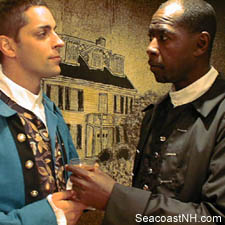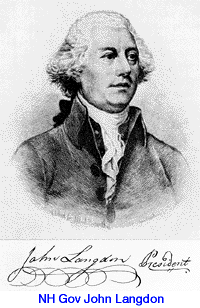|
FRESH STUFF DAILY |
|
|
||
|
|
||
|
|
||
|
SEE ALL SIGNED BOOKS by J. Dennis Robinson click here |
||
New Hampshire had slave plantations too. Modern research now shows that that wealthy northern families also kept enslaved Africans as laborers and servants as in the South. The Langdon family of Portsmouth were among the families most dependent on slave labor. John Langdon, NH’s first governor, eventually "freed" his slaves and rehired them as laborers at a minimal wage. Here is their story at last.
VISIT the Black History Trail A NORTHERN SLAVE PLANTATION
Historian Valerie Cunningham uses this chapter in our online series on slavery in Portsmouth, NH to visit the segregated Langdon slave burial ground and to introduce the characters by name (Hannah, Pomp, Nanne, Violet, Scipio). She also explores the rarely discussed topic of African-American slaves on farms in New England. (JDR) CONTENTS OF THIS ARTICLE Jump to Part 1 CONTINUE to read LANGDON FAMILY SLAVES Slaves on Northern Farms Some of New Hampshire's colonial slaves were employed in agricultural work. It is sometimes incorrectly conjectured that slaves were not used on New Hampshire farms because the area's thin and infertile soil could not support huge-scale agricultural slavery like that sustained by West Indian sugar, coffee, and cocoa plantations, Central American mahogany stands, tidewater Virginia and Rhode Island tobacco plantations, or later cotton plantations in the upland South. But a difference in scale and economy meant only a difference in the numbers of slaves applied to agricultural labor, not their absence. While most Portsmouth slaves fulfilled white needs of domestic convenience, skilled trades, and hierarchical display they unquestionably worked on farms too. Langdon Slave Burial Ground Behind the parsonage of Christ Episcopal Church on Lafayette Road is a small old burial ground. The land on the south side of Sagamore Creek was for several centuries owned by the Langdon family, and the north bank of the creek belonged to another branch of the Langdon family. Oral tradition says the burial ground behind Christ Church was for the Langdon family slaves. No corroborating written evidence verifies this tradition, but the physical evidence is consonant. The stones are small, un-inscribed, and made of readily-available local stone rather than imported slate. These features indicate low status burials. It is likely that among the slaves buried here were several who spent much of their lives working on the Langdon farm. The Langdons and their Slaves Members of the Langdon family bought slaves at intervals from the late 1600s through to the eve of the Revolution. - June 16, 1699 Captain Tobias Langdon of Portsmouth bought from Christopher Possell, a tanner in Hampton, an un-named black man about sixteen or seventeen years of age for £30. - September 10, 1718, Captain Tobias Langdon bought a "Negro Slave Named Hannah" for £36 from a J. Wentworth. - In 1724 Tobias Langdon, a wheelwright by trade, bequeathed to his son John Langdon Sr "...all my Chattel undisposed of By the will, Be it Cattle Stock Goods utensills whatsoever to me Belonging & all my Slaves...". - February 26, 1742/43, a John Langdon Sr. (1708-1780) yeoman farmer of Portsmouth bought of Jacob Tilton of Newmarket "a Negro Servant Slave named Pomp" about fourteen years of age for £150, and Tilton did "warrant Said Servant to be Sound and wel in Helth". - August 6, 1763 Joseph Langdon conveyed ownership of "one certain Negro Female Slave for Life named Nanne" (whom he had bought from his late brother Tobias) to Sarah Langdon of Portsmouth, widow of Tobias, not for money but "in consideration of the Love & Good Will that he bears to Sarah Langdon." Knowing that this gift was coming to her, the previous day Sarah Langdon provided for Nanne's possible freedom should she outlive Sarah. - March 1, 1773 Mary Langdon (wife of John Langdon, Sr. 1708-1780), bought from Elizabeth Lear of Portsmouth for £25 "a Negro Wench, named Violet" in six annual payments of £4/5/0 beginning in August of 1774 (with the provision that if she should die before the payments are complete, the payments will die with her). - Some bills for clothing a slave named Pomp also survive. On December 6, 1776 and again on July 23, 1779, John Langdon Sr. bought a pair of shoes for a slave named Pomp, each time spending 2 shillings. If this is the same Pomp as purchased in 1742/3, he would have been in his 40s by this time. CONTINUE to read AGRICULTRUAL SLAVERY The enslaved boys, men and women mentioned above likely lived and worked on the Langdon farm, or they may have been moved back and forth seasonally from farm to in-town house, according to where their labor was wanted (NB: John Langdon Jr did not build his mansion on Pleasant Street until after the Revolution; he grew up here on his father's farm). Slaves inherited by John Sr. from Tobias may have been trained wheelwrights like their former master. This skill would have been invaluable on a farm. In 1755 John Langdon, Sr. rented his slave Pomp and six oxen to a Mr. Clarkson, for two days at £14, two more days at £20, one day for £12, one more day for £12, then rented Pomp alone (without the oxen) for 2 days for "a holang of dong" for £24 . If this is the same Pomp purchased in 1742/3 he would have been about 25 years of age at this time. Neither the specific tasks nor months of Pomp's "rental" were specified. Since he was rented with oxen, Pomp Langdon was likely a trained teamster. If Mr. Clarkson was the owner of Will Clarkson, the two Africans may have hauled dung and plowed together. Will Clarkson was sometimes deputy to Portsmouth's African king Nero Brewster, and was a signer of a 1799 petition to the legislature asking for an end to slavery. Regular tasks of the New England farm in that day included: cutting and hauling timber, hauling stones from fields, or plowing fields in spring and autumn. If a teamster, Pomp directed the oxen by the traditional oral commands "gee" "haw" "come up" and "ho." Pomp grew up with the family, so he likely trained the teams himself. Perhaps Pomp is one of those buried in the Langdon's rural Slave Burial Ground. Women slaves like Mary Langdon's Violet probably worked beside their mistresses at the tasks characteristically assigned to farm women in that time. These included producing linen and woolen textiles, dairying, gardening, preserving, preparing, and serving food, doing endless household chores, and perhaps taking surplus garden produce by broad canoe or cart to sell at the market house on Spring Hill (near the present tug-boat dock). Other Examples of Agricultural Slavery in Portsmouth Scattered newspaper advertisements imply other Portsmouth cases of slaves applied to agricultural work. - An August 19, 1757 James Dwyer advertised in the New Hampshire Gazette for a run-away slave, described as a "Negro man servant named Scipio, about thirty five Years old, about Five Feet Eight Inches high, well set, and of a yellowish complexion; had on one of his Hands a Scar. Said Negro was born and brought up among the English; he understands Husbandry, mows well, and affects to be thought a Man of Sense". - On January 21, 1757 the same paper advertised "To be sold a strong healthy Negro Boy about eleven years old. In country 2 ½ years, can be well recommended to a Gentleman's Family, a farmer or tradesman. Any good master, who desires to purchase, and will pay cash, may enquire of the printer...". - In 1776 a 25-year-old slave was advertised for sale because his employer didn't have work enough to make owning and maintaining him worth the expense. His advertisement noted that the slave "understands farming business well". - Scipio's understanding of husbandry (livestock management) and skill at mowing (cutting field hay or salt-marsh hay with a scythe) suggests a lifetime of agricultural work. The advertisement for the 11-year-old assumed a market for agricultural work. Just as Langdon bought Pomp when young, this youngster was offered for sale in a culture which preferred training boys to their own standards for a valuable long-term investment. There is no doubt that slaves worked on farms in Portsmouth. Many of colonial Portsmouth's wealthiest families owned both city houses and country farms. Too little evidence is available to say whether slaves were moved seasonally or who worked solely on farms. Excerpted from From The Portsmouth Black Heritage Trail resource guide by Valerie Cunningham with Mark Sammons, all rights reserved. Copyright © 1999 Valerie Cunningham. Published online exclusively by SeacoastNH.com. Edited and by J. Dennis Robinson 2006. First published online hre in 199. Please visit these SeacoastNH.com ad partners.
News about Portsmouth from Fosters.com |
| Saturday, April 20, 2024 |


|
Copyright ® 1996-2020 SeacoastNH.com. All rights reserved. Privacy Statement
Site maintained by ad-cetera graphics

 Stories
Stories




 We have many portraits of the aristocratic Langdons, including "abolitionist" and revolutionary patriot John Landgon. But there is not a single portrait of their many slaves. Until recently our view of NH's first
We have many portraits of the aristocratic Langdons, including "abolitionist" and revolutionary patriot John Landgon. But there is not a single portrait of their many slaves. Until recently our view of NH's first 














